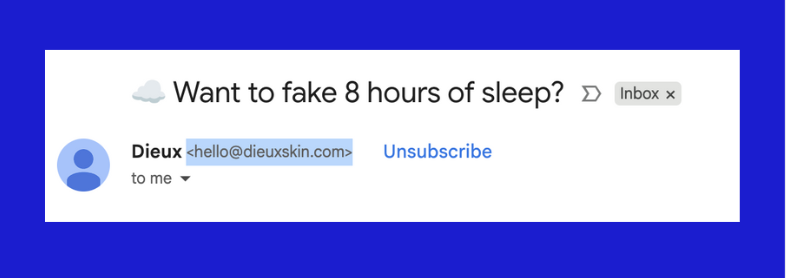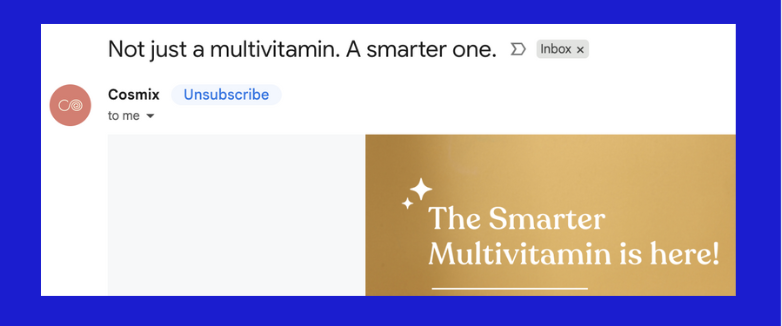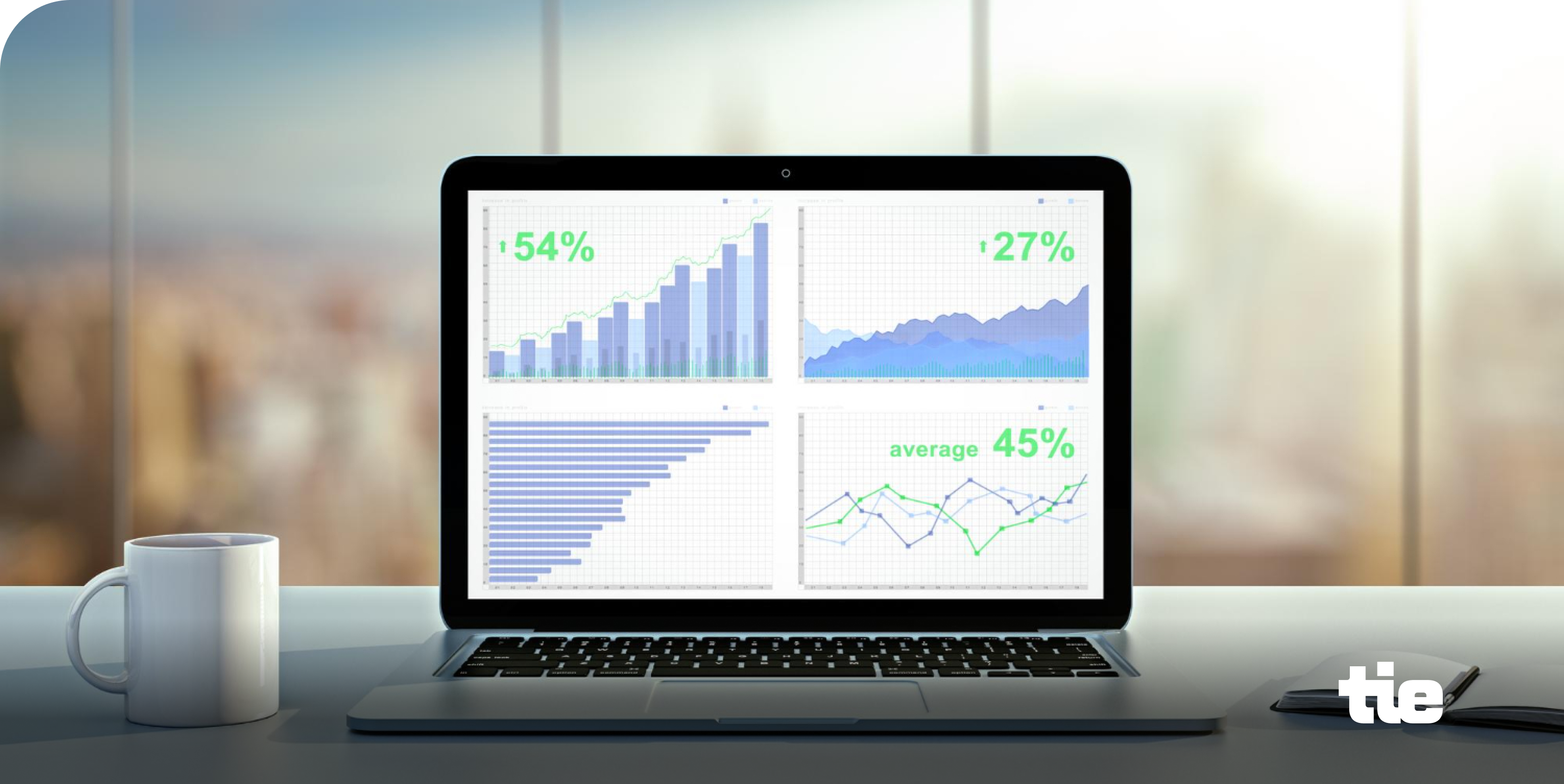Email deliverability best practices (2025): Get your emails inboxed

For most B2C brands, email is still the most cost-efficient channel to drive repeat revenue. But the majority of email programs are leaving 30–40% of that potential on the table. This is not because of creative, timing, or segmentation issues, but due to poor deliverability.
For B2C brands, weak email deliverability directly impacts revenue per send. Gmail, Yahoo, and Outlook now use engagement signals (like clicks, replies, and complaints) to decide where your emails land. If you’re not actively warming your domain, suppressing unengaged users, and monitoring inbox placement, you’re missing out on opportunities to increase your visibility.
Brands that invest in advanced deliverability systems (like domain ramping, click-based suppression, and inbox monitoring) consistently outperform. That’s exactly why Tie offers built-in tools for inbox monitoring, click-based suppression, and domain warm-up as a default infrastructure. We’ve broken down all these tactics in this guide.
If you’re looking for a hands-on walkthrough, the email deliverability checklist is a good place to start.
Why deliverability matters for B2C brands
Email is one of the highest-margin channels for B2C retention and lifecycle marketing. But without good email deliverability, every metric (open rates, click-through rates, and conversions) drops.
Brands spend millions growing their email list and optimizing email content, only to watch email performance suffer because they aren’t reaching the recipient’s inbox.
Here’s why it deserves priority:
Poor inbox placement leads to lost revenue at scale
According to GlockApps’ email deliverability data from January 2024, 1 in 4 emails sent to Yahoo, AOL, Hotmail, and Outlook users failed to reach the inbox, and 1 in 10 emails never made it to Gmail inboxes.
For brands sending 100K+ emails per campaign, even a 10–15% drop in inbox placement can mean thousands in lost revenue per send.
Inbox placement is a trust signal for mailbox providers
Gmail, Yahoo, and Apple don’t just look at authentication, but they also evaluate engagement. Consistent clicks, low complaint rates, and visible “List-Unsubscribe” headers all influence inboxing over time. If your emails aren’t performing, it’s likely due to your sender reputation, not your copy.
High deliverability compounds ROI across growth and retention
The better your inboxing, the more leverage you get from your flows, campaigns, and list-building spend. You don’t need to send more. Instead, you just need more of your emails to land where they should.
One major source of deliverability issues is anonymous, misattributed, or mistyped signups, leading to hard bounces, spam traps, and low engagement. Tie solves this by resolving user identity earlier in the funnel and validating that each email address is real, consented, and mapped to behavioral data.
Authentication & domain best practices
No matter how polished your emails are, they won’t land in the inbox if your domain setup is broken. Without authentication, Gmail, Yahoo, and Apple Mail will treat your emails as unauthenticated traffic, blocking or filtering them before they’re ever seen.
If your SPF, DKIM, or DMARC setup is misconfigured (or missing), you’re invisible by default.
To meet 2025 deliverability standards, your domain setup should include:
1. SPF, DKIM, and DMARC must be properly implemented and aligned
To ensure your emails are delivered (and not flagged as spam), you need to set up three key authentication protocols correctly and in sync:
- SPF (Sender Policy Framework): Specifies which servers are allowed to send email on behalf of your domain.
- DKIM (DomainKeys Identified Mail): Adds a digital signature to your emails, proving they haven’t been altered and confirming they came from you.
- DMARC (Domain-based Message Authentication, Reporting, and Conformance): Builds on SPF and DKIM. It tells inbox providers what to do if an email fails authentication and provides visibility into spoofing attempts.
For DMARC to function properly, either SPF or DKIM must pass—and the domain in that record must match the “From” domain in your emails (this is known as domain alignment). If DMARC is set up but SPF and DKIM aren’t aligned, mailbox providers may still treat your messages as suspicious.
To follow best practices, start with a DMARC policy of “p=none” to monitor results without impacting deliverability. Once you’ve verified proper alignment and authentication, move to stricter enforcement with “p=quarantine” or “p=reject”.
2. Always use a consistent, branded “from” domain
Gmail, Yahoo, and other ISPs evaluate sender consistency at the domain level. Jumping between subdomains like “promo@”, “deals@”, or unrelated ‘from’ addresses reduces domain reputation and confuses spam filters.
Stick to a single, recognizable domain tied to your brand, like “hello@yourbrand.com”. It builds long-term sender reputation and helps drive higher open rates by reinforcing subscriber trust.

3. Create dedicated bounce and click tracking subdomains
If you're using ESP-branded tracking domains (like “mailchimpapp.com” or “sendgrid.net”), you're borrowing someone else’s infrastructure and risking delivery degradation from shared traffic patterns.
To control and isolate your sender reputation:
- Use a custom domain like “click.yourbrand.com” for tracking links.
- Use “bounce.yourbrand.com” for return path and bounce management.
- Configure DNS records for both (SPF/DKIM, where applicable).
4. Enable BIMI and upload your verified logo.
BIMI (Brand Indicators for Message Identification) allows your brand logo to show next to your emails in supported inboxes. While it doesn’t directly impact spam filtering, it increases visual trust and can improve open rates, especially in Gmail.
To activate BIMI:
- DMARC must be set to ‘quarantine’ or ‘reject.’
- A verified logo (in SVG format) must be hosted at your domain.
- A validated VMC (Verified Mark Certificate) may be required by some providers.
5. Add a one-click List-Unsubscribe header
As of 2024, Gmail and Yahoo require a one-click unsubscribe link in the header of all promotional emails. Without it, your emails may be throttled or filtered, even with correct authentication.
Here’s why this matters:
- It reduces spam complaints by giving recipients an easy, compliant opt-out path.
- Gmail uses this as a trust signal to assess sender quality.
- CAN-SPAM and GDPR both expect fast, user-friendly unsubscribe experiences.
Use both “<List-Unsubscribe>” and “<List-Unsubscribe-Post>” headers in your HTML to meet compliance across email clients.

Need to validate your setup? Our email deliverability checklist gives you a step-by-step walkthrough of SPF, DKIM, DMARC, subdomain setup, and header compliance.
Warm-up and sending practices (especially for new domains)
Warming a new email sending domain or dedicated IP address is the only way to build credibility with mailbox providers like Gmail, Yahoo, and Microsoft. If you skip the process or ramp up volume too quickly, you’ll hit spam filters or blacklists before your campaigns even have a chance to perform.
A successful warm-up process builds positive reputation signals (valid engagement, low complaint rates, and consistent behavior) so ISPs start trusting your domain. Here’s how to do it right:
1. Follow a controlled, metrics-based volume ramp
Mailbox providers look for patterns that resemble either trustworthy senders or potential spam operations. Sudden volume spikes from a new domain raise flags, especially when targeting large B2C lists.
Here’s an example of an effective warm-up schedule:
- Day 1: 100 emails to recent clickers (past 30 days).
- Day 2: 200 emails → same cohort.
- Day 3: 400 emails.
- Day 4: 800, etc.
Only double the sending volume every 1–2 days if bounce rates stay below 2%, the complaint rate is <0.1%, and click-through rates remain healthy. These thresholds are not arbitrary. Gmail and Yahoo explicitly use them to assess sender trust.
Tip: If you see a spike in soft bounces, unsubscribes, or spam complaints, pause the ramp, review your targeting, and validate the segment before proceeding.
2. Prioritize engagement-based targeting
During the warm-up phase, avoid trying to reach your full list. You’re training ISPs to associate your sending domain with high engagement, not the number of emails you send. Only target users who are most likely to open and click:
- Users who clicked in the last 30-60 days (not just opened—post-MPP, clicks matter more).
- Recently acquired subscribers (last 14-30 days), ideally through confirmed opt-in.
- Suppress anyone with no engagement in the past 90 days.
Sending to disengaged or cold users during warm-up risks high bounce rates, low engagement, and early ISP throttling—all of which lower your inbox placement rate for future sends.
3. Maintain a predictable, steady send pattern
ISPs reward consistency. Random bursts, missed sends, or “spiky” volume behavior signal erratic or possibly malicious behavior. You should:
- Establish a consistent daily or weekly send schedule.
- Avoid big jumps in volume (e.g., from 5K to 50K in one campaign).
- Monitor sending frequency per user to avoid fatigue or triggering spam complaints.
- For triggered flows or automation, set throttle caps and ramp flow volumes gradually.
4. Choose IP infrastructure based on volume and control
Your sending IP setup directly affects how much control you have over your deliverability. Poor IP configuration or ramping without structure are some of the top reasons that brands fail to inbox consistently after a new domain launch.
Here’s how you can choose an IP infrastructure:
- Shared IPs: Suitable for brands sending <100K emails/month. But your sender reputation is shared—one bad sender in your email service provider's pool can impact your inbox placement. If you’re using a shared IP, your list hygiene and suppression logic must be airtight.
- Dedicated IPs: Required for brands sending >100K/month or with strict compliance needs. You own your sender reputation, but that also means you must warm it correctly, manage volume stability, and monitor metrics proactively.
5. Enforce a click-based sunset policy during and after warm-up
A clean list is critical, especially when building a domain and IP reputation from scratch. Keeping inactive subscribers increases your complaint risk and inflates bounce and delivery issues.
Gmail, Yahoo, and Outlook all track how many emails are ignored over time. If your engagement rates fall, your inboxing follows.
Here are some best practices to implement a click-based sunset policy during and after warm-up:
- Suppress users with no clicks in the last 60–90 days.
- Set up re-engagement flows to test intent one last time.
- If there’s still no activity, suppress them permanently.
Most brands warming up a new domain struggle with low volume, so they’re tempted to loosen targeting or reintroduce cold segments. But that is a mistake.
Looking to engage more verified contacts to warm and drive stronger early engagement? Tie’s identity resolution tools convert anonymous site traffic into known, consented subscribers so you can scale volume with real users who are already engaging with your brand across channels.
Best practices for list quality and opt-in
Gmail, Yahoo, and Outlook all track how recipients interact with your emails. If your list includes unengaged users, invalid emails, or spam traps, your entire sender reputation suffers, irrespective of how well your campaign is built.
Here are some best practices around managing list quality and opt-ins to maintain your email deliverability:
Zero tolerance for purchased or scraped lists
Sending to a purchased list is the fastest way to hit spam traps. These addresses are seeded across the web by mailbox providers to catch bad senders.
You’ll trigger blocklists, throttle your inbox rate overnight, and destroy domain/IP reputation.
Use double opt-in to eliminate fake, mistyped, or bot-generated addresses
Send a single confirmation email before adding someone to your list to ensure that only valid, interested users make it in.
This reduces hard bounces, keeps complaint rates low, and improves engagement metrics—all of which directly improve your inbox placement rate.
Immediately remove hard bounces after the first failed send.
A hard bounce means the recipient’s email address doesn’t exist. Repeatedly emailing these addresses signals to inbox providers that you’re not maintaining a clean list.
Over time, this can hurt your sender reputation, trigger spam filters, and impact deliverability, even to real, engaged subscribers.
Suppress unsubscribes and complainers globally
Never limit suppression to a single segment or campaign. Once someone unsubscribes or marks your emails as spam, they must be excluded from all future sends, including campaigns, automations, and transactional messages (unless legally required).
Sending even one more email to someone who opted out (or reported you) tells inbox providers you’re ignoring user preferences. Over time, this builds up and damages your sender reputation.
Segment based on recency of engagement, especially clicks
Sending to inactive users (especially those who haven’t clicked in 60+ days) hurts your sender reputation. Inbox providers prioritize meaningful engagement, and clicks are the strongest signal.
Set a rule: if someone hasn’t clicked in 90 days, pause them or send a re-engagement email before continuing regular sends.
Moreover, it’s just as important that the people you’re emailing genuinely opted in. Consent quality is everything. Tie helps brands build higher-quality lists by resolving anonymous visitors into verified identities, so you're not sending to low-intent, questionable contacts in the first place.
Best practices for email content and creative
Mailbox providers don't just analyze your domain. They scan every part of your email content. If your copy, formatting, or structure looks like spam, it will be treated like spam regardless of your email infrastructure. Relevant content is a critical but controllable factor in deliverability, and one of the easiest to optimize across campaigns.
Here are some email marketing best practices for deliverability content and creatives in 2025:
1. Avoid spammy language, all caps, and punctuation overload
Spam filters still flag phrases like “Buy now,” “Risk-free,” or “Act fast!!!”, especially when paired with aggressive formatting. Avoid shouting in ALL CAPS or overusing exclamation marks.
Stick to clear subject lines and natural, human-sounding copy.
2. Make unsubscribe links visible and easy to find
Gmail rewards clean opt-outs. Hiding your unsubscribe link (whether in fine print or at the very bottom) only increases spam complaints. Place it clearly in the footer, and consider making it visible above the fold in promotional emails for extra trust.
3. Use a real reply-to address and encourage engagement
Generic “no-reply” addresses reduce trust and get flagged by some ISPs. Use a monitored reply-to address, and encourage recipients to respond, especially in post-purchase or onboarding emails. Engagement signals like replies help boost inbox placement.
4. Personalize based on behavior, not just merge tags
First-name tokens aren’t enough. ISPs reward engagement (opens, clicks, replies), and that starts with relevant content.
Personalize based on real behavior like purchase history, browsing activity, or recent clicks to tailor product blocks, subject lines, and send timing.
Tie makes this easier by resolving customer identities across sessions and platforms, so you can personalize based on real behavior, not just email-level data.
5. Avoid deceptive or misleading subject lines
Subject lines like “Your order is confirmed” (when no order exists) or fake countdowns might boost short-term opens but they also spike complaint rates and erode trust.
Gmail and Yahoo track these patterns and will penalize your sender reputation accordingly.
Monitoring & troubleshooting practices
Inbox placement isn’t static. Even with clean infrastructure and high-quality content, deliverability can drop, often without warning. ISPs adjust filters constantly, and minor issues (like rising complaint rates or a spike in invalid emails) can quickly escalate if you’re not tracking the right metrics.
Here’s how to monitor and troubleshoot deliverability issues before they impact revenue:
1. Monitor bounce rate, spam rate, and inbox placement
Hard bounces usually mean fake or inactive emails are on your list—a sign of poor list hygiene or weak opt-in methods.
Spam rates over 0.1% will tank domain reputation with Gmail and Yahoo.
Most importantly, go beyond basic “delivered” stats. Use inbox placement data to see how many emails actually land in the primary inbox across major ISPs, not just the spam folder.
2. Run mailbox-specific seed tests before major campaigns
Inbox placement varies by provider. A message that lands in Gmail’s inbox might go straight to spam in Outlook.
Use testing tools like GlockApps or Litmus to preview inbox placement across Gmail, Yahoo, Outlook, etc. Don’t rely on a single test result but instead, check across providers regularly.
3. Set up feedback loops to capture spam complaints automatically
Many mailbox providers (Yahoo, AOL, Microsoft) offer feedback loops that alert you when a recipient marks your email as spam. These should be configured via your ESP or sending platform.
If you’re not receiving this data, you're missing critical insight and risking silent reputation damage.
4. Use Google Postmaster Tools and Microsoft SNDS to track sender reputation
Postmaster Tools provides Gmail-specific metrics like domain/IP reputation, spam rate, and delivery errors. Microsoft SNDS gives similar insights for Microsoft domains (Outlook, Hotmail).
If your reputation drops here, it’s a strong indicator that your emails are getting filtered, even if your ESP still reports high delivery rates.
5. Automate blacklist monitoring across domains and IPs
Use tools like MXToolbox or Talos Intelligence to get real-time alerts when your domain or IP lands on a blacklist.
This is especially important if you’re using a shared IP—where a single bad sender can poison the entire IP. Once blacklisted, all senders on that IP suffer reduced inbox rates.
To protect your reputation, rotate off blacklisted IPs quickly and consider using a dedicated IP if you're sending high volumes and want more control over deliverability.
Want to make sure you’re tracking the right signals? Check out our email deliverability checklist, which includes a full list of monitoring tools and instructions to set them up correctly.
Platform-specific best practices (Klaviyo, Mailchimp, SFMC)
Email platforms all come with different infrastructure setups, default configurations, and limitations. What works in one won’t always translate to another. Here’s what you need to get right (based on the platform you use) to maximize deliverability and protect inbox placement.
Klaviyo
Built for ecommerce, Klaviyo gives strong control over domain infrastructure and flow logic, but defaults aren’t enough. To inbox consistently on Klaviyo, you need to go beyond the standard setup and make a few non-optional upgrades.
Here are some Klaviyo email deliverability best practices that you can follow:
- Set up a dedicated sending domain early: Using Klaviyo’s default shared domain (klaviyomail.com) puts your deliverability at the mercy of other senders. Always set up a branded sending domain through DNS to isolate your reputation.
- Implement DMARC for Gmail/Yahoo compliance: As of 2024, DMARC is mandatory for bulk senders targeting Gmail or Yahoo. Without it, you risk filtered or rejected emails, even if SPF/DKIM are in place.
- Use a separate click-tracking subdomain: Klaviyo lets you track clicks via your own subdomain. This improves domain alignment and avoids issues with shared tracking setups that dilute email authentication.
- Leverage Klaviyo’s warm-up automation: When launching a new domain or ramping volume, Klaviyo’s built-in warm-up flows let you start with engaged segments and gradually scale. This protects the sender's reputation in the first 14-21 days.
- Suppress unengaged contacts using sunset flows: Use a 60–90 day no-click suppression window. As engagement decays, inbox placement suffers. Proactively removing inactive contacts helps you stay ahead of deliverability issues.
Further reading: Learn about Klaviyo tools (and experts) to boost your email marketing.
Mailchimp
Mailchimp runs on shared IPs by default, so your sender reputation depends heavily on list quality and permission practices. To maintain strong inbox placement, you need to make Mailchimp’s shared infrastructure work to your advantage.
Here are some Mailchimp email deliverability best practices that you can follow:
- Understand the risk of shared IPs: You don’t control the IP. Poor list hygiene or high complaints from other senders can affect your placement, even if your own email campaigns are clean.
- Use custom domains to authenticate your brand: Configure SPF and DKIM with your own sending domain to signal legitimacy and improve trust with mailbox providers.
- Strongly prefer confirmed opt-in for list growth: Mailchimp lists often underperform when double opt-in is skipped. Confirmed opt-in reduces bounced email rates, spam traps, and complaint risk, critical on shared infrastructure.
Salesforce Marketing Cloud
Salesforce Marketing Cloud gives full control over IPs and domain name setup, but only if you configure everything properly from day one. If you're operating on SFMC, inboxing depends on how well your technical team sets up and monitors the stack.
Here are some best practices to set this up:
- Implement the Sender Authentication Package (SAP): This configures SPF, DKIM, and domain authentication. Without SAP, ISPs will throttle or block your sends.
- Use a dedicated IP and follow a structured warm-up: SFMC doesn’t do this for you. Start with low-volume sends to recent clickers and gradually scale over 3–4 weeks to avoid triggering filters.
- Monitor inboxing with Deliverability Admin: Use it to track inbox placement, bounce spikes, complaint rates, and blocklist alerts, especially during launches or promo-heavy cycles.
Tip: Only include SFMC guidelines if the brand is using it. Otherwise, focus on Klaviyo or Mailchimp, which are more common in mid-market B2C.
ChatGPT prompts for email deliverability best practices
If you're experimenting with AI tools to optimize your email marketing program, these ChatGPT prompts can help you troubleshoot deliverability issues and improve inbox placement.
That said, leading ecommerce teams work with email experts to maximize their results. Deliverability infrastructure, DNS records, domain warming, and sender reputation issues are complex. That’s why brands work with Tie to run audits, configure authentication protocols (SPF, DKIM, DMARC), and monitor inbox placement over time.
Still, if you’re exploring or validating ideas, here are ChatGPT prompts worth testing:
Email setup and authentication
- “Outline all SPF, DKIM, and DMARC setup steps for ecommerce email marketing.”
- “Explain the difference between SPF and DKIM and how they affect sender reputation”
- “What are the best authentication protocols to improve email deliverability in 2025?”
- “Create a DNS checklist to validate SPF/DKIM records for a new email domain.”
Domain warm-up and reputation
- “Generate a 2-week warm-up plan for a new dedicated sending domain and IP address.”
- “What are the best practices for domain warming and email deliverability?”
- “How to avoid soft bounces and spam traps during email domain ramp-up?”
- “What metrics signal strong IP reputation to mailbox providers?”
Content, copy, and engagement
- “Suggest subject lines that avoid spam filters but drive clicks.”
- “What content formatting reduces chances of landing in Gmail spam folder?”
- “Give 5 email marketing deliverability best practices to improve engagement rates.”
- “What types of email content reduce unsubscribe and complaint rates?”
Platform-specific optimization
- “List Klaviyo email deliverability best practices for 2025,”
- “What are the best practices to improve email deliverability in Mailchimp?”
- “Email deliverability best practices Marketing Cloud users should follow.”
- “How should I manage list hygiene on Klaviyo vs. Marketing Cloud?”
Auditing and monitoring
- “Audit my email deliverability process for ecommerce DTC brand.”
- “What are the top causes of hard bounces and how do I fix them?”
- “How to improve inbox placement rate without increasing sending volume?”
- “Which email metrics matter most for deliverability post-Apple MPP?”
Not sure where to start? Tie’s email experts help DTC brands fix deliverability at the source—from domain setup and ramping to engagement-based list cleanup and spam folder recovery. Whether you're struggling with bounce issues, inbox placement, or reputation risks, we’ll give you real solutions, not generic fixes.
Book your deliverability audit today!
Email deliverability FAQs
What is email deliverability vs delivery rate?
Email deliverability refers to whether your emails land in the primary inbox, not spam nor promotions.
Email delivery rate is the percentage of emails sent that are successfully accepted by the recipient's mail server. You can have a 99% delivery rate and still fail at deliverability if your emails aren't seen or clicked. For DTC and ecommerce brands, deliverability is what directly impacts clicks, conversions, and revenue per email.
How do I avoid spam folders in 2025?
To avoid spam folders in 2025, you need to build trust at the infrastructure level and maintain engagement over time. Here’s how:
- Set up SPF, DKIM, and DMARC and align them with your sending domain.
- Run a domain warm-up if using a new subdomain or switching ESPs.
- Send only to engaged segments (recent clickers > recent openers).
- Keep your spam complaint rate under 0.1%.
- Avoid sudden send spikes, misleading copy, or repetitive campaigns.
How do I warm up a new sending domain?
To warm up a new sending domain, start by sending to your most recently engaged users, ideally those who’ve clicked in the last 15–30 days. Then gradually increase your volume:
- Day 1–3: Start with 500–1,000 emails/day.
- Every 2–3 days: Increase volume by 2× if bounce and spam rates stay low.
- Avoid sending to cold or purchased lists until your sender reputation is stable.
Other best practices include using a dedicated subdomain, monitoring Postmaster Tools daily, and making sure your domain is authenticated.
How do I know if I'm on a blacklist?
To understand if you're on a blacklist, use real-time monitoring tools like:
- Google Postmaster Tools (for domain & IP reputation).
- MXToolbox, Talos Intelligence, and BarracudaCentral.
- GlockApps or Mail-Tester to test inbox placement by the mailbox provider.
If you notice a sudden drop in clicks or inboxing (even with a stable list) that’s often the first sign you’ve been flagged. Check immediately before continuing to send emails.
Should I use double opt-in?
Yes, you should use double opt-in to improve list quality, lower bounce risk, and avoid spam traps. Double opt-in offers multiple benefits:
- Only real, engaged users enter your email flows.
- ESPs and ISPs see your list as permission-based and lower-risk.
- You maintain long-term domain reputation, especially important after Gmail’s 2024 spam policy update.
Most brands see higher RPE and lower unsubscribe rates from double opt-in cohorts versus single opt-in.
Does unsubscribing hurt my sender reputation?
No, unsubscribing does not hurt your sender reputation. In fact, it's a positive signal. Mailbox providers like Gmail now require a visible “List-Unsubscribe” link. This helps your brand in a few ways:
- It prevents spam complaints.
- It signals that you respect consent.
- It protects your inbox placement going forward.
The real risk comes when people can’t find an easy way to unsubscribe. That’s when complaints spike, and your domain gets penalized.
Why does Gmail put my email in Promotions?
Gmail puts your email in Promotions if it detects any combination of:
- Salesy formatting (image-heavy layouts, promotional language, discount-heavy subject lines).
- Low reply or click rates.
- Irregular sending schedules or new sender domains.
- No human interaction signals (replies, stars, moves to primary tab).
How often should I clean my email list?
You should clean your email list weekly, not quarterly. Some key rules when doing this are:
- Immediately suppress hard bounces and invalid emails.
- Use a 60-90 day click-based sunset policy.
- Re-engage stale segments with 1–2 value-driven emails before suppression.
- Monitor unsubscribe rate, spam complaints, and RPE by segment to spot decaying audiences.
What metrics matter post-Apple MPP?
Post-Apple MPP, open rates are no longer reliable and should not be used as the basis for engagement segmentation or A/B testing. Instead, the metrics that matter most are:
- Click-through rate (CTR): Mailbox providers track it as a proxy for relevance and user intent.
- Revenue per email (RPE):. Track it by flow, campaign, and segment to measure true output per send and not just engagement.
- Spam complaint rate: Must stay below 0.1%. Anything above that signals negative engagement and tanks deliverability, especially with Gmail.
- Inbox placement rate: Use tools like GlockApps or Postmaster Tools to track this. A high delivery rate doesn’t mean inboxing; placement tells you whether emails are actually seen.
- Reply rate & forward rate: Gmail and Outlook both use replies as a trust signal. Prompting replies in onboarding or post-purchase flows can improve inboxing and offset Promotions tab placement.





.png)

